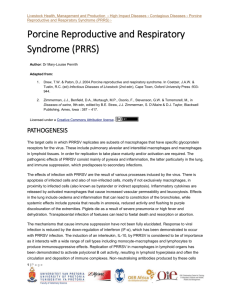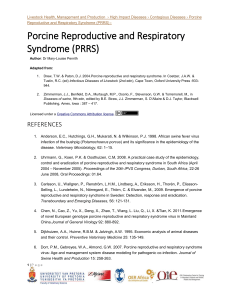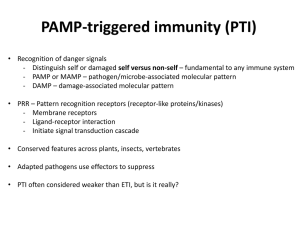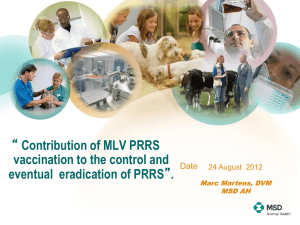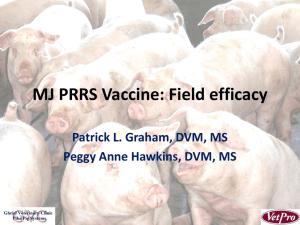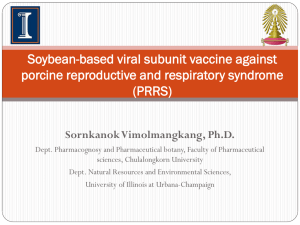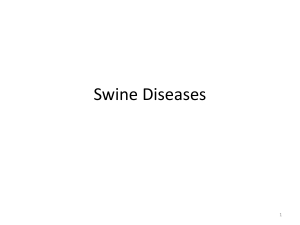prrs_complete
advertisement
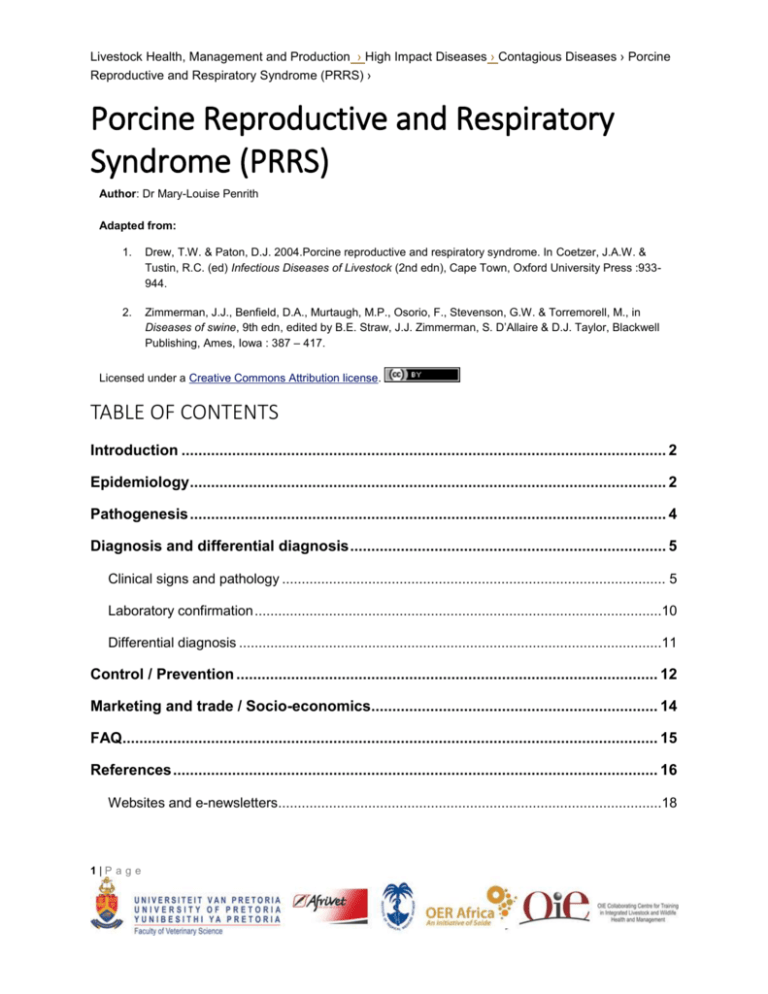
Livestock Health, Management and Production › High Impact Diseases › Contagious Diseases › Porcine Reproductive and Respiratory Syndrome (PRRS) › Porcine Reproductive and Respiratory Syndrome (PRRS) Author: Dr Mary-Louise Penrith Adapted from: 1. Drew, T.W. & Paton, D.J. 2004.Porcine reproductive and respiratory syndrome. In Coetzer, J.A.W. & Tustin, R.C. (ed) Infectious Diseases of Livestock (2nd edn), Cape Town, Oxford University Press :933944. 2. Zimmerman, J.J., Benfield, D.A., Murtaugh, M.P., Osorio, F., Stevenson, G.W. & Torremorell, M., in Diseases of swine, 9th edn, edited by B.E. Straw, J.J. Zimmerman, S. D’Allaire & D.J. Taylor, Blackwell Publishing, Ames, Iowa : 387 – 417. Licensed under a Creative Commons Attribution license. TABLE OF CONTENTS Introduction ................................................................................................................... 2 Epidemiology................................................................................................................. 2 Pathogenesis ................................................................................................................. 4 Diagnosis and differential diagnosis ........................................................................... 5 Clinical signs and pathology .................................................................................................. 5 Laboratory confirmation ........................................................................................................10 Differential diagnosis ............................................................................................................11 Control / Prevention .................................................................................................... 12 Marketing and trade / Socio-economics.................................................................... 14 FAQ............................................................................................................................... 15 References ................................................................................................................... 16 Websites and e-newsletters..................................................................................................18 1|P a g e Livestock Health, Management and Production › High Impact Diseases › Contagious Diseases › Porcine Reproductive and Respiratory Syndrome (PRRS) › INTRODUCTION Porcine reproductive and respiratory syndrome (PRRS) was first reported in 1987 from several states in the USA. Retrospective serological investigation revealed that the virus was present in pigs in both USA and Canada from the late 1970s and serologically positive pigs imported from USA were also found in South Korea and Taiwan. An outbreak was reported in Japan in 1988. The agent causing the disease was unknown and the disease was named ‘mystery disease of swine’. In 1990 outbreaks of a similar disease occurred in Germany, and in 1991 scientists at Lelystad in The Netherlands isolated a previously unknown RNA virus associated with the syndrome. In the same year another isolate of the PRRS virus was obtained in the USA. PRRS virus is classified as an Arterivirus (family Arteriviridae), like the virus that causes equine viral arteritis. The European and American genotypes are antigenically and genetically distinct from each other and the genomes diverge by approximately 40%. This has implications for the efficacy of vaccines, complicated by genetic diversity among isolates from Europe and America/Asia, with some evidence of recombination between representatives of the two genotypes, since both have become widespread in the Northern Hemisphere. PRRS is largely a disease of commercial pig herds in countries with high value industrialised pig industries and is one of the most researched diseases of pigs. RNA viruses are prone to undergoing changes that involve antigenicity and sometimes pathogenicity as well. Since its first clinical appearance the disease has changed in endemic countries from an acute, severe disease with high mortality to an often mild to subclinical disease that causes losses in vulnerable pigs e.g. those suffering from weaning stress at a time when they have lost their maternal immunity and newly introduced pigs from different herds, as well as due to increased susceptibility to secondary infections, particularly of the respiratory system. However, in 2006, after PRRS had been present in the country since 1995, China experienced widespread outbreaks of a severe disease with high morbidity that was characterised by high fever and could cause mortality of up to 50% or more, caused by a PRRS virus that differed genetically from the viruses previously circulating in China and elsewhere. This form of PRRS has spread to Vietnam, Cambodia and other south-east Asian countries like Myanmar, and has aroused fears of emergence of more virulent forms of PRRS elsewhere. EPIDEMIOLOGY The apparently sudden emergence of PRRS on two continents raised the question of where it could have originated. Pigs are the only species in which PRRS virus is known to cause disease, and so far investigation of a range of species including raccoons, skunks, cats, dogs, mice, starlings and sparrows has shown them not to be susceptible to infection. It is presumed that a wild host must have been involved, but so far none has been identified. Migratory waterfowl have been proposed as vectors of PRRSV spread between farms, due to their migratory nature and their tendency to nest on or near to 2|P a g e Livestock Health, Management and Production › High Impact Diseases › Contagious Diseases › Porcine Reproductive and Respiratory Syndrome (PRRS) › swine farm lagoons and the fact that PRRSV can survive in water for up to 11 days and in swine lagoon effluent for up to 7 days. Mechanical transmission of the virus by some insect vectors has been demonstrated but there is no evidence that PRRS is an arbovirus. Pigs become infected by contact with pigs that are shedding virus or their secretions and excretions; virus has been shown to persist for up to 42 days in saliva. Routes of infection under natural conditions are oro-nasal, venereal, transplacental and via wounds, e.g. when fighting and biting. Iatrogenic transmission via contaminated needles and equipment used during procedures such as tail docking, ear notching, tooth clipping and castration is considered important. Mechanical transmission by mosquitoes and flies has been demonstrated. Airborne transmission has been difficult to achieve experimentally over distances greater than 2.5 metres but is considered to be possible in cold damp conditions, as outbreaks have occurred that would be difficult to explain by other means. Similarly, transmission via swill feeding has been achieved experimentally by feeding large amounts of infected pork to pigs that had been starved, but evidence for natural transmission by this means is lacking. The South African outbreaks have been assumed to have resulted from swill feeding as there does not appear to be any other explanation, but the origin of the outbreaks could not be traced. If swill was involved it was likely to have consisted of raw offal because the only tissues in which PRRS virus has been shown to persist for longer periods are lung, tonsils and lymph nodes. Pigs have been infected by contact with contaminated clothing, equipment and hands of people working with them and fomites can play a role in within and between herd spread. Susceptible pigs of any age can be infected but in endemic herds pigs are usually infected in the first weeks of life. Viraemia usually develops 12 to 24 hours post infection and peaks 7 – 14 days post infection. It usually wanes and is no longer apparent after 28 days, but may persist for longer, particularly in congenitally infected pigs. However, recovered pigs remain persistently infected for varying periods of time with virus that replicates at low levels in tonsils and/or lymph nodes, and these pigs, especially those that remain persistently infected for protracted periods, are considered an important source of infection for other pigs because, although they are not necessarily viraemic, infective virus may be shed in saliva. Introduction of infected pigs into susceptible herds has been demonstrated to be the most important source of infection, followed by infected semen and fomites or slurry. PRRS virus is shed in saliva, urine and faeces but the virus is fragile and unable to persist for long in the environment. It is sensitive to temperature and the higher the temperature the more rapidly infectivity is lost; even at 4°C 90% of infectivity is lost within one week, although low titres of infectious virus may be detected for as long as 28 days. Infectivity is rapidly lost at pH levels below 6 and greater than 7.5. Humid conditions are required for persistence in the environment as the virus is rapidly inactivated by desiccation. PRRS is principally a disease of large commercial pig herds and is strongly associated with pig-dense areas where farms are separated by 2 km or less. However, in South Africa smallholder pigs were mainly affected, and low levels of infection have been demonstrated in feral pigs in the USA. 3|P a g e Livestock Health, Management and Production › High Impact Diseases › Contagious Diseases › Porcine Reproductive and Respiratory Syndrome (PRRS) › The PRRS outbreaks in RSA occurred in smallholder pigs Smallholder pig farm, Western Cape, affected by PRRS PATHOGENESIS The target cells in which PRRSV replicates are subsets of macrophages that have specific glycoprotein receptors for the virus. These include pulmonary alveolar and interstitial macrophages and macrophages in lymphoid tissues. In order for replication to take place maturity and/or activation are required. The pathogenic effects of PRRSV consist mainly of pyrexia and inflammation, the latter particularly in the lung, and immune suppression, which predisposes to secondary infections. The effects of infection with PRRSV are the result of various processes induced by the virus. There is apoptosis of infected cells and also of non-infected cells, mostly if not exclusively macrophages, in proximity to infected cells (also known as bystander or indirect apoptosis). Inflammatory cytokines are released by activated macrophages that cause increased vascular permeability and leucocytosis. Effects in the lung include oedema and inflammation that can lead to constriction of the bronchioles, while systemic effects include pyrexia that results in anorexia, reduced activity and flushing to purple discolouration of the extremities. Piglets die as a result of severe pneumonia or high fever and dehydration. Transplacental infection of foetuses can lead to foetal death and resorption or abortion. The mechanisms that cause immune suppression have not been fully elucidated. Response to viral infection is reduced by the down-regulation of interferon (IF-α), which has been demonstrated to occur with PRRSV infection. The induction of an interleukin, IL-10, by PRRSV is considered to be of importance as it interacts with a wide range of cell types including monocyte-macrophages and lymphocytes to produce immunosuppressive effects. Replication of PRRSV in macrophages in lymphoid organs has been demonstrated to activate polyclonal B cell activity, resulting in lymphoid hyperplasia and often the circulation and deposition of immune complexes. Non-neutralising antibodies produced by these cells may enhance viral infectivity (antibody-dependent enhancement). Destruction of the macrophages in 4|P a g e Livestock Health, Management and Production › High Impact Diseases › Contagious Diseases › Porcine Reproductive and Respiratory Syndrome (PRRS) › which the virus replicates reduces the defences against bacterial infection as these cells are responsible for the phagocytosis and killing of bacteria. DIAGNOSIS AND DIFFERENTIAL DIAGNOSIS Diagnosis of PRRS is complicated by the variability of the clinical signs among age groups and the fact that once the disease has become endemic in herds no clinical signs may be apparent. In these herds the only evidence of the presence of PRRS, apart from serological evidence, may be failure to reach production targets due to increased susceptibility to other diseases, in particular those affecting the respiratory tract. Laboratory confirmation of any suspected case is therefore essential. Clinical signs and pathology Clinical signs depend on the virus strain, host’s immune status, concurrent infections and how the pigs are managed. There are no pathognomonic or even consistent clinical signs. The presentation of PRRS ranges from a subclinical to a severe and sometimes highly fatal disease. Dead pigs showing skin flushing due to fever PRRS epidemics in naïve herds typically commence with pigs of all ages developing fever indicated by anorexia and lethargy. 5|P a g e Livestock Health, Management and Production › High Impact Diseases › Contagious Diseases › Porcine Reproductive and Respiratory Syndrome (PRRS) › Flushed feverish pig with PRRS Some pigs may show reddening of the skin and/or cyanosis of the extremities; the latter gave rise to the name ‘blue ear disease’. Morbidity can vary from 5 – 75% and spread throughout the herd is rapid. Blue discolouration of the ears may occur in PRRS 6|P a g e Blue discolouration of the ears may occur in PRRS Livestock Health, Management and Production › High Impact Diseases › Contagious Diseases › Porcine Reproductive and Respiratory Syndrome (PRRS) › Feverish pigs showing skin flushing and huddling together 7|P a g e Purple blotches on the extremities of a pig with PRRS Livestock Health, Management and Production › High Impact Diseases › Contagious Diseases › Porcine Reproductive and Respiratory Syndrome (PRRS) › Sows of any parity may abort litters, or farrow litters close to, at or a little after their due date that may include normal piglets, weak small piglets, stillborn fresh piglets, and autolysed and partially to completely mummified piglets. Abortions are the main indication of PRRS in adult sows Sows may show no clinical signs apart from negative effects on reproduction or may develop agalactia, nervous signs, pneumonia or exacerbation of existing conditions such as mange and cystitis/pyelonephritis. Mortality in sows is generally less than 5% but sows that recover may show delayed return to oestrus and/or low conception rates in the next cycle. Boars, in addition to fever and respiratory signs, may have reduced libido and semen quality; however, shedding of virus in semen has been demonstrated to be a potent source of infection. Pre-weaning mortality may increase to as much as 60%, and a high proportion of the piglets may show various abnormalities such as periocular oedema, splay legs, failure to suckle resulting in starvation and emaciation, severe dyspnoea and anaemia. Watery diarrhoea has been described but is not consistent. 8|P a g e Livestock Health, Management and Production › High Impact Diseases › Contagious Diseases › Porcine Reproductive and Respiratory Syndrome (PRRS) › Pigs with PRRS may develop severe diarrhoea Weaner and grower pigs show mainly signs of fever with anorexia, lethargy, skin discolouration and rough hair coats, with varying degrees of respiratory distress, and up to 20% of pigs may die. The incidence of other infectious diseases is increased and these may include meningitis caused by Streptococcus suis, bacterial bronchopneumonia, Glässer’s disease, salmonellosis, and mange. PRRS usually becomes endemic in infected herds, and clinical disease is usually only observed in highly susceptible groups like weaned pigs in which passive immunity has waned and naïve pigs introduced into the herd like gilts and young boars. However, exposure to a different strain of virus may result in epidemic PRRS as the degree of cross-protection between strains is variable. PRRS has also been incriminated as the major cause of porcine respiratory disease complex (PRDC) which manifests as slow growth, decreased feed efficiency, anorexia, fever, coughing and dyspnoea in weaning and finishing pigs. Reproductive failure in sows and temporary infertility in boars may also been seen in affected herds. A wide range of respiratory pathogens as well as porcine circovirus -2 have been implicated in PRDC but coinfection with swine influenza virus and Mycoplasma hyopneumoniae appears to be frequent (Dorr et al. 2007). The highly virulent form of PRRS that emerged in China in 2006 is characterised by high fever with up to 100% of pigs affected and with 20 – 50% mortality (Zhou et al. 2010). There are no pathognomonic pathological lesions but enlarged lymph nodes and interstitial pneumonia affecting the cranial lobes or the entire lungs are consistently seen in pigs that die of PRRS, usually sucklers and weaners up to 70 days of age. Affected lungs are mottled, do not collapse, and may be variably rubbery, red and oedematous, depending on the severity of the pneumonia. Lymph nodes are moderately to greatly enlarged, tan-coloured and oedematous, progressing to becoming paler and firm. Microscopic lesions consist of round cell infiltrates in alveolar septa of the lung and in multiple organs around blood vessels (perivascular cuffing). In cases of longer duration in older pigs lesions of secondary infections may be present in the lungs, sometimes obscuring the lesions caused by PRRS. 9|P a g e Livestock Health, Management and Production › High Impact Diseases › Contagious Diseases › Porcine Reproductive and Respiratory Syndrome (PRRS) › Apart from the abnormal composition of aborted to full term litters, which can consist of normal, freshly dead, autolysed and mummified piglets, there are no foetal lesions that are useful for diagnosis of PRRS. Laboratory confirmation It has been emphasised previously that laboratory confirmation of PRRS is absolutely essential. As for all diseases, laboratory confirmation depends upon the suitability and quality of the samples submitted. The limited pH and temperature tolerance of PRRS virus makes careful handling of samples important and they should be kept at 4°C and transported to the laboratory as soon as possible. Serum, tonsils, lymph nodes, and lung are the preferred samples in an acute outbreak, while in older cases tonsils and lymph nodes may be the only tissues that still contain sufficient virus for detection. From aborted foetuses, lung, liver, kidney and spleen should be collected to prepare 20% tissue homogenates for viral isolation attempts. Thoracic fluids have also been used for viral isolation. The gold standard for diagnosis is viral isolation with confirmation by a fluorescent antibody test (FAT) or immunohistochemistry (IHC) to detect viral antigen. PRRS virus only grows in a limited number of cell lines, and in particular the European viruses have a strong preference for pig pulmonary alveolar macrophages. It is recommended that culture should be attempted in more than one cell line. Because of the difficulties encountered in viral isolation a pig bioassay is considered the most sensitive assay for detection of PRRSV. Seroconversion or detection of replicating virus in a young pig injected with a homogenate of the sample indicates that it contained PRRSV. Viral antigen may be detected in frozen tissues (lung tissue is usually used) by means of an FAT or in formalin-fixed tissues (lung, lymph nodes, spleen, thymus, tonsil) by IHC. FA tests are more rapid but IHC is more sensitive and is the only option for formalin-fixed tissues. Both techniques require skilled performance and interpretation. For detection in foetuses, live-born or freshly dead foetuses from affected litters are preferred because autolysed and mummified foetuses rarely yield virus. PCR-based assays to detect viral RNA are more sensitive and specific than viral isolation, FA or IHC, the results are available within 1 – 3 days and detection is possible in samples like faeces, autolysed foetuses and semen. A positive PCR does not necessarily mean that the virus is infectious, but it can be followed by culture if the sample is suitable and it provides proof that the pig was infected with PRRS virus. Infection of pigs with material that was positive for PRRSV by means of polymerase chain reaction (PCR) assays but from which virus could not be isolated has been reported, and this was interpreted as indicating that the infective dose for pigs might be very low. However, another, more probable interpretation is that culture failed because of the fastidiousness of the virus. Antibody detection is not the ideal way to diagnose an outbreak of PRRS, particularly in a previously infected or vaccinated herd, unless paired samples (acute and convalescent) are taken to demonstrate a rising titre, because the available tests do not distinguish between infected and vaccinated animals. 10 | P a g e Livestock Health, Management and Production › High Impact Diseases › Contagious Diseases › Porcine Reproductive and Respiratory Syndrome (PRRS) › Demonstration of the agent is always preferable, since antibodies also do not necessarily indicate current infection. In the case of PRRS, in persistently infected pigs the virus may be present in tonsils and lymph nodes when antibodies are no longer detectable, and the seronegative pigs will be assumed to be uninfected. The standard serological test for antibodies is a commercial ELISA with good sensitivity and specificity and potentially able to detect antibodies to both the North American and European-type viruses. Suspicious positive results may be confirmed by an indirect fluorescent antibody test (IFA) or by a blocking ELISA. Serological testing for antibodies to PRRS is used for herd monitoring but is usually combined with screening by PCR. In herds without clinical signs pigs of 9 – 16 weeks old are the best group to sample to detect circulating virus (Duinhof et al. 2011). The diagnostic tests used for PRRS are described in Chapter 2.08.07 of the OIE Terrestrial Manual for Diagnostics and Vaccines available as a pdf file on the OIE website (OIE 2011). Differential diagnosis Differential diagnoses for PRRS include diseases that result in reproductive failure, namely porcine parvovirus, Aujeszky’s disease, porcine enteroviruses, classical and African swine fever, haemagglutinating encephalomyelitis virus and leptospirosis, and respiratory infections like swine influenza and cytomegalovirus. The enlarged lymph nodes are also suggestive of post-weaning multisystemic wasting syndrome caused by porcine circovirus-2. Any of these infections and many others may be concurrent with and potentiated by PRRS infection and therefore diagnosing one or more of them does not necessarily rule out PRRS. Skin lesions on the hind legs can resemble classical swine fever or porcine dermatitis and nephropathy syndrome 11 | P a g e Livestock Health, Management and Production › High Impact Diseases › Contagious Diseases › Porcine Reproductive and Respiratory Syndrome (PRRS) › CONTROL / PREVENTION Prevention of PRRS depends upon the implementation of strict biosecurity measures for which detailed protocols have been worked out in endemically infected countries, in particular the USA. The purpose of the biosecurity measures is to ensure that no PRRSV is able to gain access to the pigs. This entails identifying all the possible ways in which the virus might be introduced to the farm and ensuring that appropriate barriers are in place to prevent an incursion. The most important sources of PRRSV are live infected pigs and infected semen, which are relatively easy to exclude by ensuring pigs and semen come from negative herds and isolating live pigs for at least 30 days, but a number of other possible transmission routes have been identified, some of which are more difficult to prevent than others. Transmission of PRRSV via fomites that include contaminated clothing and footwear, hands, equipment and needles has been confirmed and biosecurity measures have to include issues of protective clothing and footwear, thorough washing and disinfection of hands and equipment, and using one needle per pig except perhaps in the case of piglets belonging to the same litter. Vehicles that transport pigs have been identified as having a very high risk of transmitting the virus. Effective cleaning, disinfection and drying protocols have been developed for vehicles but it has been pointed out that these are not easily applied to the entire vehicle. In damp and cold conditions, material that clings to the underside of the vehicle, like snow balls and mud balls, and may fall off and be transferred to footwear have been shown to be capable of containing infective quantities of PRRS virus. Excluding vehicles from the pig area altogether by having loading/unloading facilities at points along the perimeter is ideal. Mosquitoes and flies are competent mechanical transmitters of PRRSV and should therefore be excluded as far as possible. This is not possible in outdoor or semi-outdoor farming systems but measures should at least be in place to control insects for example by minimising suitable breeding sites. Although other species such as birds and rodents are apparently not susceptible to PRRSV or able to transmit it, their exclusion from pig facilities is an essential part of any biosecurity protocol, as is avoiding the feeding of swill to pigs, although the probability of transmission of PRRSV by swill, as discussed previously, appears to be very low. Not all of the means of ‘neighbourhood spread’ have been identified with any certainty; pig farms, particularly in pig dense areas, have become infected when it could be demonstrated that none of the usual means of entry had taken place. It must therefore be accepted that, although aerosol transmission over distances has not been reliably proven, it is likely that it may occur under particular circumstances involving cold and humid conditions. For this reason, proximity to roads along which pigs are transported is regarded as a risk factor for becoming infected, as is proximity to other piggeries. Since the location of a pig farm in relation to roads and other farms can usually not be changed, some of the risk factors are not susceptible to mitigation, although it may be possible to locate facilities as far from the perimeter as possible and to protect pigs from the prevailing winds. 12 | P a g e Livestock Health, Management and Production › High Impact Diseases › Contagious Diseases › Porcine Reproductive and Respiratory Syndrome (PRRS) › Vaccination does not form part of the strategy to protect uninfected herds. Vaccines have been developed and are potentially an important tool in strategies for managing PRRS. However, the heterogeneity of PRRSV presents a challenge. There are two major genotypes, European (EU) and North American (NA). In addition to differing genetically from one another, the strains within the two genotypes are themselves clinically, antigenically and genetically heterogeneous. Both genotypes have become widespread, and in many countries both genotypes occur. Some viruses used in the production of modified-live vaccines have become established as field viruses, and recombination between vaccine viruses and field viruses has occurred. Mixed infections involving both EU and NA genotype viruses have been recorded in the same herd, and cross protection between the two does not occur. The efficacy of vaccination is also reduced by the ability of PRRSV to evade the immune system, resulting in a delayed response to vaccination and reduced ability of the immune system to mount an adequate anamnestic response.. Control of PRRS in infected herds consists of minimising the negative effects on production. One of the main objectives is to produce piglets that are negative for PRRSV at weaning. This is achieved by ensuring that the breeding herd is immune and the sows will therefore not be shedding virus during gestation and farrowing so that transplacental infection does not occur and the piglets do not become infected by their dams. The key to maintaining the immunity of the breeding herd is to ensure that the gilts that are introduced have been exposed to the virus or viruses circulating in the herd and are immune by the time they enter the breeding herd. Ensuring that infection has taken place presents challenges and vaccination of the gilts with modified-live vaccines and sometimes additionally with inactivated vaccines may form part of the acclimatization protocol. Vaccination with modified-live vaccine may also be used at herd level to increase protective immunity and should be applied to all the pigs within a particular air space at the same time. The problems of cross-protection have been discussed previously. If a recent infection has occurred in the breeding herd, a temporary closure during which no new gilts are introduced for a period of 2 – 4 months may be able to minimise the effects of the virus. Control of PRRS in weaned and growing pigs focuses on controlling pig flow in order to limit contact between pigs of different infection status. All-in-all-out management, preferably using different sites for different stages of production, greatly facilitates control of PRRS. Where this is not possible, partial depopulation to interrupt the flow can result in considerable improvement. A combination of vaccination with modified-live vaccine and ensuring that the pig flow takes place only in one direction has also been applied successfully. It has also been stressed that controlling concurrent infections by vaccination and, if appropriate, medication is important to minimise the effects of PRRS infection on weaners and growers. Eradication has proven extremely difficult in countries that have become endemically infected, because the risk of re-infection is very high. Recent introductions of PRRS offer a better chance of eradication but the measures are drastic and require considerable resources, in particular sufficient veterinary officers to carry out the operation swiftly. The eradication of PRRS from Sweden, which had been free until seven infected herds were detected in 2007, has been described. It was achieved by stamping out the infected herds, followed by cleaning and disinfection of the infected premises and an empty period of three weeks before restocking was permitted. As soon as the infection was detected, spread was prevented by 13 | P a g e Livestock Health, Management and Production › High Impact Diseases › Contagious Diseases › Porcine Reproductive and Respiratory Syndrome (PRRS) › mobilisation of veterinarians in the public and private sectors and of the pig industry. Other countries that have achieved eradication of PRRS incursions are Chile and South Africa; in Chile PRRS had become endemic in a limited area before it was detected and the national eradication programme that was developed was in operation for several years. Disposal of carcasses after culling Eradication of PRRS within herds in endemically infected countries sometimes requires depopulation/repopulation, which is costly, and if eradication is achieved it is most likely to be sustainable on multi-site farms in areas of low pig density. Individual herds have been successfully cleared and maintained free of infection by using mass vaccination with a modified-live vaccine, depopulating the nursery and managing the rest of the pigs on a strict all-in-all-out basis. Maintaining freedom from infection requires implementation of the strictest biosecurity measures as outlined previously. The level of risk of re-infection and the ability of the producer to implement the necessary biosecurity measures to mitigate any risks identified should be determined before embarking on herd-level eradication. When eradication of PRRS has been undertaken either at national or at herd level, it should be followed by a programme of intensive monitoring and surveillance with serological screening for both antibodies and circulating virus to confirm that eradication has been achieved and that re-infection has not occurred. MARKETING AND TRADE / SOCIO-ECONOMICS PRRS is considered the most economically important disease of pigs worldwide. This is largely because a very high number of high value potentially high-producing commercial herds in countries with high value export markets are infected. The economic losses are not in general due to export bans but to pigs taking longer to reach market weight, increased expenses for medication and veterinary services, and fewer 14 | P a g e Livestock Health, Management and Production › High Impact Diseases › Contagious Diseases › Porcine Reproductive and Respiratory Syndrome (PRRS) › pigs for sale owing to reduced reproduction and increased pre-weaning losses. Production costs are also increased in PRRS-free herds in endemic areas owing to the increased costs of heightened biosecurity. Although the OIE has taken the decision not to maintain PRRS as a notifiable disease or to provide trade standards for it since such a large number of member states are affected, certain countries, notably Australia and New Zealand, do impose trade bans on countries that are not free of PRRS, thereby reducing the number of potentially high value markets open to them. Impressive figures reflecting the cost to producers and pig industries of PRRS are sometimes quoted, but in practice losses due to animal disease are difficult to quantify accurately as there are numerous factors to be considered and not all of the costs of animal disease are necessarily borne by the industry. It has been pointed out that statistics aimed at demonstrating the magnitude of economic losses due to a particular animal disease are often meaningless because the conceptual basis of the estimates is not defined. Nevertheless, it can be taken for granted that producers with PRRS-free herds are likely to make more money out of their enterprises than producers living with PRRS. At the same time, a cost/benefit analysis might in many cases reveal that the cost of eliminating PRRS may not be justified by the benefits reaped, particularly if eradication were to be undertaken at national level in long-time endemically infected countries. On the other hand, for countries that do not have PRRS, some investment in measures to keep the disease out may be justified provided the measures are underpinned by sound science and a good understanding of the risks of introduction. FAQs 1. How did PRRS spread so rapidly over such a wide area so soon after it emerged as a new disease? Nobody knows the answer to that, but it is likely that it occurred mainly with the importation of live pigs and semen before the disease was recognised as an entity. 2. Why has PRRS become such an important disease of pigs? Its importance is explained by the fact that it emerged and became widespread in highly industrialised pig production systems where most pig diseases were well controlled and fatal pig diseases such as classical and African swine fever had largely been eradicated, combined with the difficulty of eliminating it. 3. Why does the OIE not treat it in the same way as other serious diseases of pigs like the swine fevers? PRRS occurs endemically in the majority of important pig-producing countries and, apart from trade in live pigs and semen, has had little effect on trade compared with diseases like the swine fevers; it is 15 | P a g e Livestock Health, Management and Production › High Impact Diseases › Contagious Diseases › Porcine Reproductive and Respiratory Syndrome (PRRS) › an erosive disease whose control is regarded as being largely the responsibility of producers rather than governments. 4. What effect would PRRS have on smallholder and traditional pig producers if it were to become widespread in Africa? It is difficult to predict what effect it would have in the long term. In the short term, since outbreaks of PRRS in naïve herds tend to cause serious disease, sometimes with high mortality, the effects might be serious to devastating. If PRRS became endemic, with clinical disease becoming uncommon, its effect in low production systems could vary from unnoticeable to fairly serious and would probably depend on the degree to which the immune suppression increased the incidence of other diseases. However, fortunately most of the diseases of intensification are not observed in smallholder or traditional pig rearing systems. REFERENCES 1. Anderson, E.C., Hutchings, G.H., Mukarati, N. & Wilkinson, P.J. 1998. African swine fever virus infection of the bushpig (Potamochoerus porcus) and its significance in the epidemiology of the disease. Veterinary Microbiology, 62: 1–15. 2. Uhrmann, G., Koen, P.K. & Oosthuizen, C.M, 2008. A practical case study of the epidemiology, control and eradication of porcine reproductive and respiratory syndrome in South Africa (April 2004 – November 2005). Proceedings of the 20th IPVS Congress, Durban, South Africa, 22-26 June 2008, Oral Proceedings: 01.64. 3. Carlsson, U., Wallgren, P., Renström, L.H.M., Lindberg, A., Eriksson, H., Thorén, P., Eliasson-Selling, L., Lundeheim, N., Nörregard, E., Thörn, C. & Elvander, M., 2009. Emergence of porcine reproductive and respiratory syndrome in Sweden: Detection, response and eradication. Transboundary and Emerging Diseases, 56: 121-131. 4. Chen, N., Cao, Z., Yu, X., Deng, X., Zhao, T., Wang, L. Liu, Q., Li, X. &Tian, K. 2011.Emergence of novel European genotype porcine reproductive and respiratory syndrome virus in Mainland China.Journal of General Virology 92: 880-892. 5. Dijkhuizen, A.A., Huirne, R.B.M. & Jalvingh, A.W. 1995. Economic analysis of animal diseases and their control. Preventive Veterinary Medicine 25: 135-149. 6. Dorr, P.M., Gebreyes, W.A., Almond, G.W. 2007. Porcine reproductive and respiratory syndrome virus: Age and management system disease modeling for pathogenic co-infection. Journal of Swine Health and Production 15: 258-263. 16 | P a g e Livestock Health, Management and Production › High Impact Diseases › Contagious Diseases › Porcine Reproductive and Respiratory Syndrome (PRRS) › 7. Drew, T.W. & Paton, D.J. 2004.Porcine reproductive and respiratory syndrome. In Coetzer, J.A.W. & Tustin, R.C. (ed) Infectious Diseases of Livestock (2nd edn), Cape Town, Oxford University Press :933-944. 8. Duinhof, T.F., van Schaik, G., van Esch, E.J.B. & Wellenberg, G.J. 2011. Detection of PRRSV circulation in herds without clinical signs of PRRS: Comparison of five age groups to assess the preferred age group and sample size. Veterinary Microbiology 150: 180-184. 9. Holtkamp, D.J., Yeske, P.E., Polson, D.D., Melody, J.L., Philips, R.C. 2010. A prospective study evaluating duration of swine breeding herd PRRS virus-free status and its relationship with measured risk. Preventive Veterinary Medicine 96: 186-193. 10. Lunney, J.K., Benfield, D.A., Rowland, R.R.R. 2010. Porcine reproductive and respiratory syndrome virus: An update on an emerging and re-emerging viral disease of swine. Virus Research 154:1-6. 11. Magar, R. & Larochelle, R. 2004. Evaluation of the presence of porcine reproductive and respiratory syndrome virus in pig meat and experimental transmission following oral exposure. Canadian Journal of Veterinary Research, 68: 259-266. 12. Molina, R.M., Nelson, M.A., Christopher-Hennings, J., Hesse, R., Rowland, R.R.R. & Zimmerman, J.J. 2009. Evaluation of the risk of PRRSV transmission via ingestion of muscle from persistently infected pigs. Transboundary and Emerging Diseases, 56: 1-8. 13. Nöremark, M., Lindberg, A., Vågsholm, I., Sternberg Lewerin, S. 2009. Disease awareness, information retrieval and change in biosecurity routines among pig farmers in association with the first PRRS outbreak in Sweden. Preventive Veterinary Medicine 90: 1-9. 14. OIE 2011 Chapter 2.08.07 Porcine reproductive and respiratory syndrome. Terrestrial Manual for Diagnostics and Vaccines 2011, http://www.oie.int/fileadmin/Home/eng/Health_standards/tahm/2.08.07_PRRS.pdf 15. Pharo, H. & Cobb, S.P. 2011. The spread of pathogens through trade in pig meat: Overview and recent developments. Revue Scientifique et Technique, Office International des Épizooties 30: 139148. 16. Polson D. & Hartsook, G. 2008. Successful PRRS elimination in a 5000 sow farrow-to-finish system through mass vaccination and pig flow. Proceedings of the 20th IPVS Congress, Durban, South Africa, 22-26 June 2008, Oral Proceedings: 01.52. 17. Sanford, S.E. 2002. PRRS – new methods of transmission. 22nd Centralia Swine Research Update, Kirkton, Ontario, 29 January 2002: I-34 – I-36. 17 | P a g e Livestock Health, Management and Production › High Impact Diseases › Contagious Diseases › Porcine Reproductive and Respiratory Syndrome (PRRS) › 18. Thanawongnuwech, R. & Suradhat, S. 2010. Taming PRRSV: Revisiting the control strategies and vaccine design. Virus Research 154: 133-140. 19. Torremorell, M., Rojas, M., Cuevas, L., de la Carrera, F., Lorenzo, F., Osorio, F. & Henry, S. 2008.National PRRSV eradication program in Chile. Proceedings of the 20th IPVS Congress, Durban, South Africa, 22-26 June 2008, Oral Proceedings: 01.55. 20. Zhou Y-J, Hao X-F, Tian G-Z, Yoo D, An T-Q, Zhou T, Li G-X, Qiu H-J, Wei T-C, Yuan X-F. 2008. Highly virulent porcine reproductive and respiratory syndrome virus emerged in China. Transboundary and Emerging Diseases 55: 152 – 164. 21. Zimmerman, J., Benfield, D.A., Murtaugh, M.P., Osorio, F., Stevenson, G.W. & Torremorell, M. 2006.In: Straw, B.E., Zimmerman, J.J., D’Allaire, S. & Taylor, D.J. (eds). Diseases of Swine.9th edn, Blackwell Publishing, Ames, Iowa,: 387 – 417. Websites and e-newsletters 1. OIE Terrestrial Manual (www.oie.int) 2. ThePigSite (www.thepigsite.com/pig health/) 3. ThePigSite Newsletter (newsletters@5mpublishing.com) 4. Pig Progress (www.pigprogress.net) 5. PRRS Coordinated Agricultural Project (www.prrs.org) 6. URL for chapter in OIE Terrestrial Manual: http://www.oie.int/fileadmin/Home/eng/Health_standards/tahm/2.08.07_PRRS.pdf 18 | P a g e
